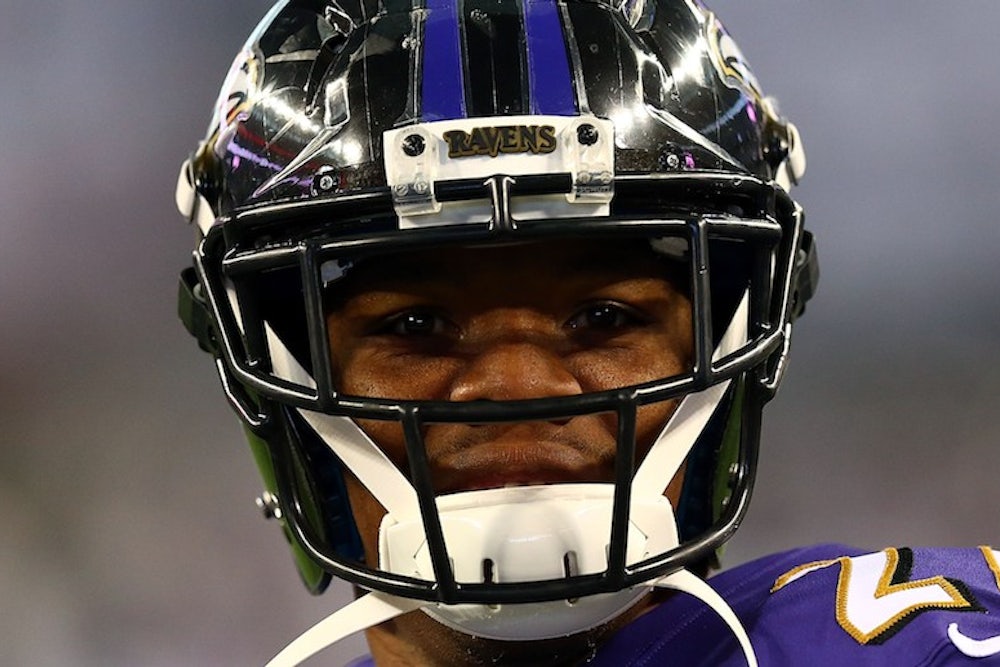In recent years, a fairly extensive industry has sprung up around the association between the kind of concussive brain injury professional football players sustain and various neurological problems. (See here, here, here, here, here, here…) We’ve even got a term for the consequences of repetitive brain trauma: chronic traumatic encephalopathy (CTE), and centers like Boston University’s dedicated to studying it.
What is less well understood, however, is the specific connection between CTE and violent behavior. Can the repetitive head trauma actually make people more violent? As FiveThirtyEight has demonstrated, the arrest rate among NFL players for violent crimes is much higher than their income level would predict. Is it possible to trace this to the neurological damage they inevitably sustain?
According to Dr. Alison Brooks of the University of Wisconsin Madison, it’s not that simple. As Brooks points out, many football players are prone to high-risk behavior to begin with (seeing as they chose to be football players), and risk-taking individuals tend to be more inclined towards drugs, alcohol, and aggressive behavior. For many of these individuals, any number of additional factors might contribute to violent behavior: steroid use, drug and alcohol abuse, and underlying mental health issues.
Dr. Michael Wolf, a pediatrician specializing in sports medicine at St. Christopher’s Hospital for Children in Philadelphia and on the faculty at Drexel University School of Medicine also cautioned against drawing a line from concussive brain damage to violent behavior. “In medicine,” Dr. Wolf explains, “we’re very resistant to make big claims based on isolated events.” andré douglas pond cummings, an associate dean and professor of law at Indiana Tech who used to represent NFL players (and, yes, possibly a distant relation of the poet) thinks that culture has a lot to do with this as well: “We lionize [the players]. We let them get away with not behaving properly or we don’t make them responsible for their actions. … They live in a very violent world. Violence on the field is part of how they make their living.”
Nonetheless, countless studies over the years have looked at various populations with histories of both violence and of brain trauma. One famous study from 1986 looked at 15 death row inmates and found that all of them had experienced a traumatic head injury in childhood. A 1996 report looked at 279 Vietnam War Veterans who suffered penetrating brain injuries found that those with damage to a particular part of the frontal cortex demonstrated more aggression.
As Wolf points out, though, many of the studies that are done retrospectively are problematic. (He compares them to thinking about exposure to various carcinogens only after being diagnosed with cancer.) And moreover, they don’t examine the population we’re trying to draw conclusions about: NFL players. Wolf suggested that even if NBA players were used as a control, and football players were indeed found to commit domestic abuse more often than basketball players, we still wouldn’t be able to determine if this correlation is because they play football or because football simply attracts the type of person who also commits domestic abuse. According to Wolf, a better study would involve following every kid who checks into an ER with a concussion for decades to see how their brains developed and how their behavior evolved.
Then there’s the matter of more fully understanding what actually happens when the brain gets concussed and which kinds of concussive experiences (several severe concussions spaced out over a person’s life versus many repetitive, smaller concussions) are causing CTE. The current leading theory is that the brain damage caused by a concussion is the result of a “shear injury,” a deep, cellular strain on the brain caused when the brain gets, as Dr. Brooks puts it, “spun.”1 Researchers would also need to determine if shear injuries can cause damage similar to, for example, the brain-penetrating injuries that affected the frontal lobes (and the demonstrated aggression) of the Vietnam veterans.
Until we learn more about concussions and their consequences, most doctors agree that it’s critically important to make sure that we’re treating concussions seriously and properly. The current culture, however, which many call “playing through the pain,” makes it difficult to keep concussed players at rest. A recent study, coauthored by Wolf, concluded that the longer a player had been professional, the less likely he was to miss a game. He was also less likely to skip a game as the season went on. The study did find, though, that when new concussion treatment guidelines were introduced in 2009, the odds of a player returning within sevens days of a concussion dropped significantly. Most adult males need a week to ten days to recover from a concussion, according to Wolf. A culture that encourages recuperation could help science, as well; protective protocols, like having players meet with specialists and doctors to evaluate cognitive functioning and more accurrately assess symptoms, might even help detect the potential presence of CTE while a player is still alive. (Currently, we can only determine if an individual has developed CTE after he has died.)
Whatever the science finds, experts agree that a deeper investigation is crucial to the survival of the sport. “If we leave questions unanswered, you’re gonna end up with parents making the broad decision not to allow kids to play,” says Wolf. “That’s how football will die—from the ground up.”
What Brooks is referring to is a kind of brain jostling that results from an impact whose force doesn’t pass through the brain’s center of gravity. We used to think concussions were the result of the brain bouncing against the walls of a person’s skull, but increasingly rotational motion that “stretches cells and brain tissue” is considered the likely culprit for the kind of damage concussions inflict.
